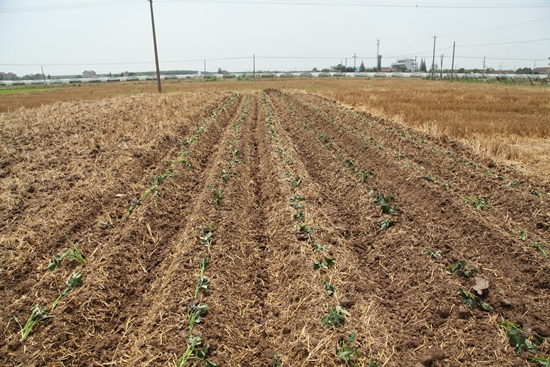分享到
2ZFG-2 Sweet Potato Combined Transplanter Newly Developed
Recently, the sweet potato research team of Nanjing Research Institute for Agricultural Mechanization (NIAM) and the cooperative enterprise jointly developed 2ZFG-2 sweet potato combined transplanter. The transplanter which matches with 75~110 horsepower tractor can complete rotary tillage, ridging, stubble breaking, transplanting and reshaping operations at one time. It provides solid foundation to achieve full mechanization in sweet potato farming.
According to the introduction, sweet potato is usually planted in the high ridge (ridge height 25 ~ 30cm, ridge distance 80 ~ 90cm). Because of its special physiological characteristics, the form that bare-root transplanting is used in sweet potato, and the bare-root is sheared (pulled) before transplanting. Because of the restriction of technology that separates seedlings, nowadays fully automatic transplanting can’t be achieved all over the world. For Rotary tillage, soil preparation and ridging should be done at first when mechanical transplanting begins, then transplanter begins working towed by tractor. But as a result, it is difficult to match the tractor wheel distance and ridge distance. Ridge is easy to break when tractor wheels go in ditch, and it has high requirements for tractor size and driver. The planting process is complicated, the frequency of tractor works in field is high, and the cost of energy consumption and human resources is high. The top of the ridge is easily crushed or damaged by transplanter in the planting process in some kind of sand soil. In order to avoid affecting the growth and yield later, it needs to be reshaped again by manual.
To solve the problems, sweet potato research team developed 2ZFG-2 type sweet potato combined transplanter after more than three years of research and did the field performance tests and conducted experiments in Nantong and Haimen etc. The transplanter can be away from the rotary tillage, ridging components to implement stubble breaking, transplanting and reshaping operations independently to meet different power configuration and multilevel consumption demands.



According to the introduction, sweet potato is usually planted in the high ridge (ridge height 25 ~ 30cm, ridge distance 80 ~ 90cm). Because of its special physiological characteristics, the form that bare-root transplanting is used in sweet potato, and the bare-root is sheared (pulled) before transplanting. Because of the restriction of technology that separates seedlings, nowadays fully automatic transplanting can’t be achieved all over the world. For Rotary tillage, soil preparation and ridging should be done at first when mechanical transplanting begins, then transplanter begins working towed by tractor. But as a result, it is difficult to match the tractor wheel distance and ridge distance. Ridge is easy to break when tractor wheels go in ditch, and it has high requirements for tractor size and driver. The planting process is complicated, the frequency of tractor works in field is high, and the cost of energy consumption and human resources is high. The top of the ridge is easily crushed or damaged by transplanter in the planting process in some kind of sand soil. In order to avoid affecting the growth and yield later, it needs to be reshaped again by manual.
To solve the problems, sweet potato research team developed 2ZFG-2 type sweet potato combined transplanter after more than three years of research and did the field performance tests and conducted experiments in Nantong and Haimen etc. The transplanter can be away from the rotary tillage, ridging components to implement stubble breaking, transplanting and reshaping operations independently to meet different power configuration and multilevel consumption demands.



By Hu lianglong
hurxbb@163.com
hurxbb@163.com
Latest News
-
 Apr 18, 2024Opening Ceremony of the Training Workshop on Wheat Head Scab Resistance Breeding and Pest Control in Africa Held in CAAS
Apr 18, 2024Opening Ceremony of the Training Workshop on Wheat Head Scab Resistance Breeding and Pest Control in Africa Held in CAAS -
 Apr 03, 2024IPPCAAS Co-organized the Training Workshop on Management and Application of Biopesticides in Nepal
Apr 03, 2024IPPCAAS Co-organized the Training Workshop on Management and Application of Biopesticides in Nepal -
 Mar 28, 2024Delegation from the School of Agriculture and Food Science of University College Dublin, Ireland Visit to IAS, CAAS
Mar 28, 2024Delegation from the School of Agriculture and Food Science of University College Dublin, Ireland Visit to IAS, CAAS -
 Mar 25, 2024Director of World Food Prize Foundation visited GSCAAS
Mar 25, 2024Director of World Food Prize Foundation visited GSCAAS -
 Mar 20, 2024Institute of Crop Sciences (ICS) and Syngenta Group Global Seeds Advance Collaborative Research in the Seed Industry
Mar 20, 2024Institute of Crop Sciences (ICS) and Syngenta Group Global Seeds Advance Collaborative Research in the Seed Industry
